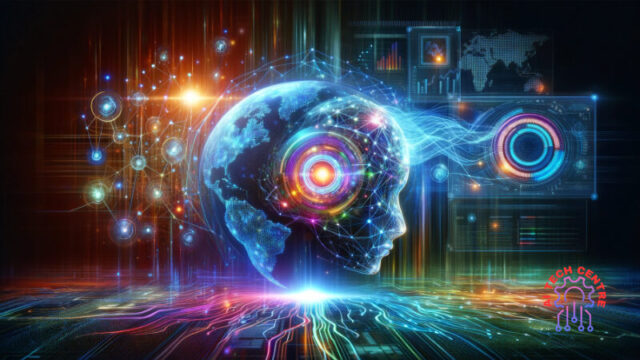Introduction
Artificial Intelligence (AI) has become a buzzword that is frequently heard in various industries. It refers to the simulation of human intelligence in machines that are programmed to think and learn like humans. AI has the potential to revolutionize businesses and society as a whole. Therefore, it of great important for everyone to know something about Artificial intelligence for beginners.
What is Artificial Intelligence?
Artificial Intelligence refers to the ability of machines to imitate and perform tasks that typically require human intelligence. This includes learning, problem-solving, speech recognition, decision-making, and more. AI systems can analyze vast amounts of data, identify patterns, and make predictions to aid in decision-making processes.
Importance and Applications of Artificial Intelligence
The importance of AI lies in its ability to automate tasks, increase efficiency, and improve accuracy. It has a wide range of applications across various industries, including healthcare, finance, manufacturing, transportation, and customer service. AI can enhance medical diagnosis, automate financial transactions, optimize production processes, enable self-driving vehicles, and provide personalized customer experiences. The potential of AI is immense, and businesses that harness its power can gain a significant competitive advantage in today’s rapidly evolving world.
History of Artificial Intelligence
Early Beginnings of AI Research

The history of artificial intelligence dates back to the 1950s when researchers first began exploring the concept of machines that could think and learn like humans. Significant contributions were made by pioneers such as Alan Turing and John McCarthy, who laid the foundation for AI research.
During this early period, AI research focused on developing algorithms and models that could mimic human cognition. Researchers worked on areas such as problem-solving, language processing, and logical reasoning to create intelligent machines.
The AI Winter and Resurgence
In the late 1960s, the field of AI faced a setback known as the “AI Winter.” The high expectations for AI technologies were not met, resulting in a decline in funding and interest. However, the field experienced a resurgence in the 1980s with advancements in computational power and algorithmic improvements.
This resurgence led to breakthroughs in areas such as machine learning, neural networks, and expert systems. AI technologies began to be incorporated into various industries, fueling further research and development.
Today, AI has evolved into a powerful tool with applications that range from virtual assistants to autonomous vehicles. The history of AI showcases the perseverance and innovation of researchers, paving the way for future advancements in this rapidly evolving field.
Types of Artificial Intelligence
Narrow AI and General AI
Artificial Intelligence can be broadly categorized into two types: Narrow AI and General AI.
Narrow AI, also known as weak AI, refers to systems designed to perform specific tasks with great precision and accuracy. These AI systems are focused on solving particular problems and are not capable of general human-like intelligence. Examples of narrow AI include virtual assistants like Siri and Alexa, as well as recommendation algorithms used by streaming platforms.
On the other hand, General AI, also known as strong AI or human-level AI, refers to systems that possess the same level of intelligence and cognitive abilities as humans. General AI has the capacity to understand, learn, and apply knowledge across a wide range of tasks and domains. However, the development of General AI is still in its early stages and remains a topic of ongoing research and exploration.
Machine Learning and Deep Learning
Machine Learning and Deep Learning are two key subsets of AI that enable systems to learn from data and make predictions or decisions.
Machine Learning involves the use of statistical techniques and algorithms to enable machines to improve their performance on a specific task through experience. By analyzing and learning from data, machine learning algorithms can identify patterns, make predictions, and make informed decisions.
Deep Learning, on the other hand, is a subset of machine learning that focuses on artificial neural networks. These networks are designed to mimic the structure and function of the human brain, enabling machines to learn from unstructured data such as images, audio, and text. Deep learning algorithms have revolutionized areas such as computer vision, natural language processing, and speech recognition.
These types of artificial intelligence, including Narrow AI, General AI, Machine Learning, and Deep Learning, play crucial roles in various industries and are at the forefront of technological advancements.
AI Algorithms and Techniques
Supervised and Unsupervised Learning
Supervised learning is a type of machine learning algorithm where the model is trained on labeled data to make predictions or classifications. It involves providing the algorithm with input data and the corresponding correct output results. Through this training process, the model learns to recognize patterns and make accurate predictions when given new input data.
On the other hand, unsupervised learning is a type of machine learning algorithm where the model is trained on unlabeled data. This means that the algorithm does not have access to the correct output results during the training process. Instead, it focuses on finding patterns, relationships, and structures within the data. Unsupervised learning is commonly used for tasks such as clustering, dimensionality reduction, and anomaly detection.
Reinforcement Learning and Neural Networks
Reinforcement learning is a type of machine learning algorithm where an agent interacts with an environment and learns to make decisions through trial and error. The agent receives feedback in the form of rewards or penalties based on its actions, and its goal is to maximize the cumulative reward over time. Reinforcement learning has been successfully used in various applications, including robotics, game playing, and autonomous driving.
Neural networks are a fundamental component of many AI algorithms, including deep learning. They are computational models inspired by the structure and function of the human brain. Neural networks consist of interconnected layers of nodes, called neurons, that perform computations on the input data. Through a process called training, neural networks can learn to recognize complex patterns and make accurate predictions or classifications.
These AI algorithms and techniques, including supervised and unsupervised learning, as well as reinforcement learning and neural networks, contribute to the development and advancement of artificial intelligence in various domains and industries.
Common AI Technologies
Natural Language Processing
Natural Language Processing (NLP) is a branch of AI that deals with the interaction between computers and human language. It involves analyzing and understanding human language to enable computers to process, interpret, and generate natural language. NLP algorithms are used in various applications such as chatbots, voice assistants, sentiment analysis, and language translation.
Computer Vision
Computer Vision is another exciting field of AI that focuses on enabling machines to see and interpret visual data from images or videos. Computer vision algorithms enable computers to identify objects, detect patterns, and analyze visual content. Applications of computer vision include image recognition, object detection, facial recognition, and medical imaging.
These common AI technologies, including Natural Language Processing and Computer Vision, play a significant role in advancing AI capabilities and finding practical applications across industries. With continuous advancements and research in these fields, we can expect further breakthroughs that will impact various aspects of our lives.
Ethical Considerations in Artificial Intelligence
Bias and Fairness in AI Systems
As AI becomes more integrated into our daily lives, it is crucial to address issues of bias and fairness in AI systems. AI algorithms are trained on vast amounts of data, and if this data contains biases or reflects societal inequalities, it can lead to biased outcomes. Ensuring fairness in AI systems involves careful data curation, regular audits to identify and mitigate biases, and diversifying the teams involved in AI development to mitigate unconscious biases.
Privacy and Data Security Concerns
The increasing use of AI systems raises concerns about privacy and data security. AI systems often rely on large amounts of personal data to function effectively. It is vital to establish clear regulations and protocols to protect user data, ensure transparency in data collection practices, and implement strong security measures to prevent unauthorized access. Striking the balance between utilizing personal data for AI advancements and safeguarding individuals’ privacy rights is a challenge that requires ongoing attention and vigilance.
Addressing these ethical considerations in AI is crucial to ensure that AI systems are developed and deployed in a responsible and ethical manner, ultimately benefiting society as a whole. Ongoing discussions, research, and collaborations among stakeholders are necessary to navigate these complex ethical considerations effectively.
Real-World Applications of AI
Healthcare and Medicine
Artificial Intelligence (AI) has made significant advancements in the field of healthcare and medicine. It has the potential to revolutionize disease diagnosis, treatment planning, and patient care. AI algorithms can analyze large amounts of medical data, including patient records, lab results, and medical images, to identify patterns and make accurate predictions. This can lead to earlier detection of diseases, more personalized treatment plans, and improved patient outcomes. Additionally, AI-powered robots and chatbots are being used in healthcare settings to assist with tasks such as monitoring patients, providing medical advice, and delivering medications.
Finance and Banking
The finance and banking industry has also embraced AI to streamline processes and enhance customer experiences. AI algorithms can analyze vast amounts of financial data to detect patterns, identify fraudulent activities, and make predictions for investment strategies. AI-powered chatbots are being used to provide personalized financial advice to customers, while virtual assistants and voice recognition technology are facilitating convenient and secure banking transactions. Furthermore, AI is also being utilized for credit scoring and risk analysis, helping financial institutions make more informed decisions and optimize their operations.
These real-world applications of AI in the healthcare and medicine as well as finance and banking industries demonstrate the immense potential and benefits that AI can bring to various sectors. As technology continues to advance, AI is expected to play an even more significant role in shaping industries and improving the quality of services provided to customers.
Future Trends and Challenges in AI
Artificial General Intelligence (AGI)
Artificial General Intelligence (AGI) is the goal of creating AI systems that possess the ability to understand, learn, and perform tasks at a human level. While current AI systems are limited to specific domains or tasks, AGI aims to achieve broad and versatile intelligence. The development of AGI could have profound implications for industries and society as a whole, but it also presents several challenges such as ensuring the ethical and responsible use of such powerful technology.
Job Displacement and Workforce Impact
As AI technology continues to advance, there is a growing concern about the potential displacement of jobs and its impact on the workforce. AI has the capability to automate routine and repetitive tasks, which can lead to job losses in various industries. However, it is also important to note that AI can augment human capabilities, enabling individuals to focus on more complex and strategic tasks. Addressing the potential job displacement and upskilling the workforce to adapt to the changing job landscape will be crucial in the future.
Overall, the future trends and challenges in AI, such as the development of AGI and potential job displacement, require careful consideration and proactive measures to ensure the responsible and beneficial integration of AI technologies.
Conclusion
Recap of Key Concepts
In this blog section, we discussed the future trends and challenges in AI. We explored the concept of Artificial General Intelligence (AGI), which aims to create AI systems capable of understanding and performing tasks at a human level. While AGI has the potential to revolutionize industries and society, it also presents ethical and responsible use challenges.
We also touched upon the concern of job displacement and the impact on the workforce. AI’s ability to automate routine tasks may lead to job losses, but it can also enhance human capabilities and enable individuals to focus on more complex tasks.
The potential of Artificial Intelligence for the Future
Looking ahead, the future of AI holds immense potential. With further advancements, AI can bring about innovative solutions, improve efficiency, and facilitate decision-making in various industries. However, it is crucial to address the challenges and ensure the responsible integration of AI technologies for the benefit of society.
As AI continues to evolve, it will be important for businesses and policymakers to stay informed, adapt, and actively shape the path forward to harness the full potential of this transformative technology.







